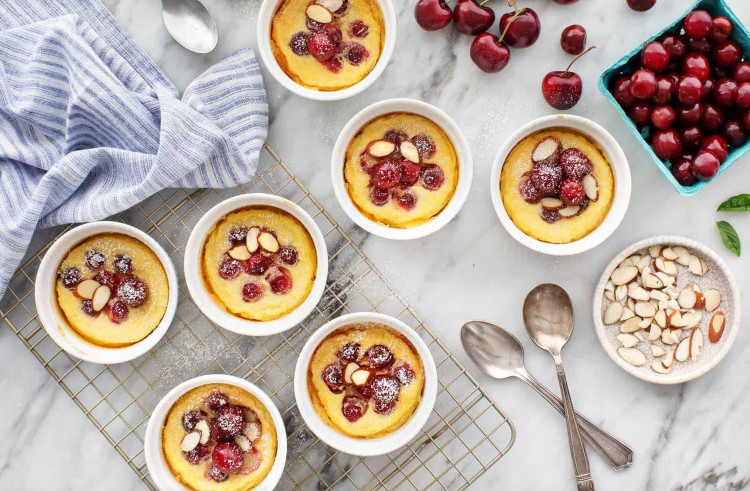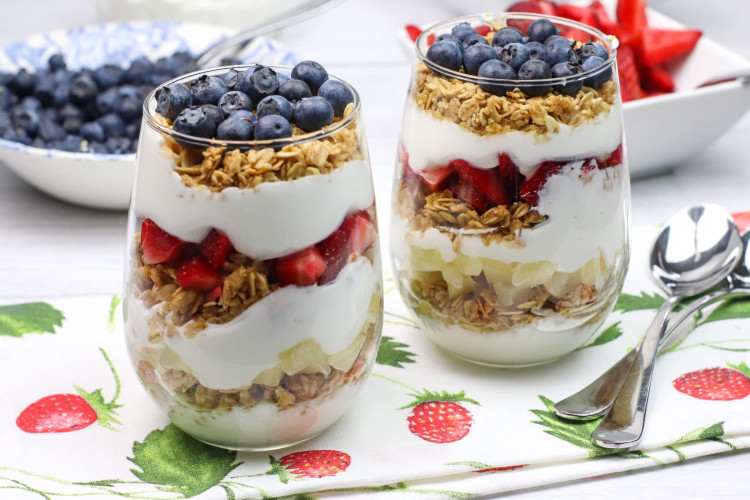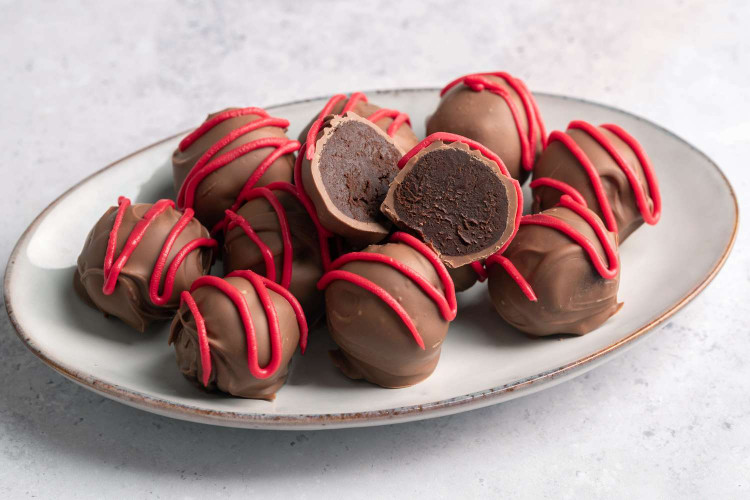
Desserts are big business, a quick look at TV adverts (and supermarket shelves) clearly demonstrates how eager companies are to persuade us that a great meal needs to be ended with dessert and to sell us what we need to make that happen.
There’s actually an element of truth to this, dessert can round off a meal very nicely.
The point to remember, however, is that those same TV spots and supermarket shelves are also full of products which highlight the struggles many of us have with maintaining a healthy weight.
There’s more to healthy desserts than fruit (but it helps)
The healthiest dessert out there is a fruit salad and sometimes that hits the spot perfectly.
If we’re honest, however, even in summer, when the choice of seasonal fruit is at its widest, eating a fruit-based dessert all the time can get a bit dull (and if we’re really honest, sometimes it’s the healthiness of fruit which takes away the fun, we want something a bit naughty but not too naughty).
In winter, there is less seasonal fruit and a whole lot more cold weather, which makes hot “comfort food” desserts more appealing.
It’s unlikely to be a coincidence that many traditional hot desserts are based around fruit, but with added ingredients such as pastry, crumble or just custard, for extra taste, sweetness and “comfort factor”.

It’s hard to avoid all the dire warnings about the state of the nation’s health and it’s hard to argue that sugar is certainly one factor in this, hence the controversial “sugar tax” on soft drinks.
The reality, however, is that there are usually a number of factors involved in determining whether or not a person leads a healthy lifestyle, of which their level of sugar consumption is just one.
It’s also worth remembering that there is nothing inherently unhealthy in sugar in and of itself, fruit, for example, contains sugar, that’s what gives it its sweet taste, what is unhealthy is consuming excessive amounts of sugar, particularly highly-processed sugar such as the ground cane sugar commonly sold in supermarkets (even the brown sort) and used in commercially-prepared desserts.
If you’re following the guidelines for a healthy lifestyle and your weight is around what it should be, then the occasional “naughty” treat here and there is fine, particularly if you make a commitment to working it off afterwards.
The key word is “occasional”.
Healthy desserts need to be more nice than naughty
Desserts are a bit of a grey area as they’re typically used to round off a dinner (and sometimes a lunch), which means that potentially they’re something we could eat every day, but at the same time, for many people a dessert is a treat and a simple piece of fruit is unlikely to make the grade, at least, not without a bit of help. So here is one approach to managing desserts, we call it the “traffic light system”.
Green - most of your desserts, pure fruit or something very close to it.
Orange - healthy desserts, a bit naughtier than pure fruit, but overall pretty good for you.
Red - real treat food, to be enjoyed occasionally.
So how does that work in practice.
Well, let’s ignore red for now because there are plenty of dessert recipes and ready-made desserts available for when you’re just going to ignore the healthy-eating guidelines for once and focus on green and orange.

“Green” desserts
This essentially means fruit, possibly with a few healthy additions.
The way to turn a piece of fruit into an appealing dessert is to use presentation to enhance it. Let’s give an example. Handing someone a banana at the end of a meal is hardly the most exciting way to end it.
Take the same banana, peel it, cut it into slices (removing any brown bits unless the person actually likes them) and arrange it on a small plate in the shape of a flower and you turn the same banana into a visually attractive dessert.
Take some white grapes, cut them in half (remove the seeds if necessary) and add them as “leaves” and you make it even more special.
Similarly, instead of just taking out a pot of yoghurt and a piece of fruit, put the yoghurt into a pretty container and add the fruit, in fact even without the fruit, just putting yoghurt into a nicer container makes it look more special.
This visual trick actually works even if you are making the dessert for yourself and really the amount of extra effort it involves is minuscule.
There’s plenty of online inspiration for presenting fruit (and indeed vegetables) in an imaginative way, Pinterest is always a good place to start.
NB: Parents may wish to check with a health professional before deciding whether it is appropriate to give low-fat products to their children.
While children need to avoid excessive fat consumption, they do require fat as fuel for growth and hence it may actually be healthier for them to eat full-fat products, albeit in moderation.
Adults should note that low-fat products may be less healthy than you might think from the way they are often promoted, for example, they may compensate for the reduction in fat by adding extra sugar to improve the taste.
“Orange” desserts
These are desserts which are a step further down the “treat” line than their green counterparts, but are still massively healthier than “red” desserts.
They tend to be based largely on fruit but add extra elements with a bit more “naughtiness”. Here are a few ideas.

Buried Treasure (for children) or Fruit and Yoghurt Parfait (for adults)
Serves 4
450g Greek yoghurt
500g Fruit
The quantities are just guidelines, you can adapt them to your taste (and what you have handy). All you need to do is put a layer of fruit at the bottom of a serving glass, add another layer of Greek yoghurt and then top off with more fruit.
You can use whatever fruit you want.
If you’re having this at lunch-time, bananas are a great choice as they are full of resistant starch, which is a complex (i.e. healthy) carbohydrate, which releases energy over a long period.
They’re also full of potassium and magnesium, which are both good for keeping a healthy heart. Blackberries and blueberries both make good partners for bananas and have plenty of health benefits of their own.
Of course, you can use whatever fruit you want, if, however, you’re using tinned fruit, it’s best to drain it first, otherwise the dessert can get a bit wet, you can drink the juice separately or use it for something else. If you want a bit of extra sweetness, then you can always add some honey.
In principle, you can swap out Greek yoghurt for another kind, but read the label before you do as some yoghurts are a much less healthy than you’d link from the advertising.

(Coco)Nutty Bananas
Serves 4
2 Bananas
4 Teaspoons cocoa powder or organic/fair trade hot chocolate
4 Teaspoons dessicated coconut
Cut up the banana to suit your preference, roll the slices in the cocoa powder and then either roll in the dessicated coconut or just dip one or both flat sides in it.
This is great finger food and is “treat” enough to be used as an after-dinner dessert.
The main ingredient is bananas, which are very healthy.
Cocoa powder has a chocolate taste, but is free of all the unhealthy elements which commonly go into mass-produced chocolate bars (like fat and sugar).
If you can’t find cocoa powder or find that you do want something a bit sweeter, organic and/or fair trade hot chocolate tends to have a much higher ratio of cocoa powder to sugar than mainstream hot chocolate brands and hence may be a suitable alternative.
Desiccated coconut is naturally sweet, which is why it is often used in desserts, but it is also full of healthy properties, in fact coconut is arguably one of nature’s wonder plants, which is why it has so many uses.

Crunchy Chewy Chocolate Truffles
100g Dried (pitted) dates, chopped
200ml Water
1 Tablespoon lemon juice
2 Tablespoons honey
2 Tablespoons peanut butter (crunchy or smooth)
2 Tablespoons cocoa powder
15g Unsalted butter
50g Rolled (porridge) oats
100g Biscuit (cracker) crumbs
Again, ingredients are approximate, this is a recipe you make largely by feel, literally.
The starting point is to simmer the dates, water, and lemon juice over a medium heat until they form a paste, which usually takes about 15 minutes.
Then add butter, peanut butter, honey, and cocoa powder, mixing thoroughly until they are completely combined. Now is the point where you start to work by feel.
Add in the rolled oats so the mixture becomes much more solid.
Then start to add the biscuit crumbs a little at a time until you get the consistency you want, if need be make some more crumbs and add them.
Once you have it right, roll up the mixture into balls, whatever size you like and chill for 30 minutes before serving (or storing in an airtight container).
Basically the key to just how healthy this recipe is lies in what kind of biscuit crumb you use.
The reason why the amount of crumb you need may vary is partly because the texture will depend on what type of crum you use and partly because the choice of smooth or crunchy peanut butter will also influence the texture.
This recipe can be enjoyed at any time of year and is particularly good at Christmas when treat food and sweets seem to be everywhere and going without them can seem particularly hard.

Strawberry Sponge Cake
Serves 6
1 Tablespoon sweetener
1 Tablespoon cornflour
250ml Fresh orange juice
1/4 Teaspoon vanilla or almond extract
250g sliced fresh strawberries
Combine the sweetener and cornflour in a small saucepan without any heat.
Add a little of the orange juice and mix well, then turn on the heat, keeping it low to start with.
Add the remainder of the orange juice a bit at a time, mixing well and bringing up the heat as you go until the orange juice comes to the boil.
Once it reaches the boil, keep stirring as the mixture thickens.
It usually takes about a minute for it to come to a sauce-like consistency.
If you’d like it a bit thicker, just add some extra cornflour, if it becomes too thick, add more orange juice.
Then take the orange juice off the heat and stir in the extract.
Allow the sauce to cool completely outside the fridge, then transfer to the fridge to store if you’ve made it in advance.
When you are ready to use, add the strawberries to the sauce and serve with pieces of sponge.
Depending on your time and your audience, you could opt for the more elegant presentation of spooning it over a piece of sponge cake, or putting it into a ready-made sponge dessert shell or serving it “Eton Mess”-style i.e. just breaking the sponge cake into chunks and mixing it with the strawberry sauce in a serving glass.
While the addition of sponge cake does put this dessert into the “orange” category, it is still a massive improvement over its counterpart of strawberry shortcake.
Conclusion
Desserts can often be the most tasty part of a meal, certainly if you have a bit of a sweet tooth - so instead of trying to give them up altogether, why not try and see if you can get the same enjoyment out of a healthy option. Instead of depriving yourself, improvise and maybe improve!
Do you have any healthy dessert recipes to share? Get in touch, I’d love to add to my list so do share.
Article written by John Bennett from www.classy-content.com - John is a retired journalist and actually writes for free for sites that he enjoys













